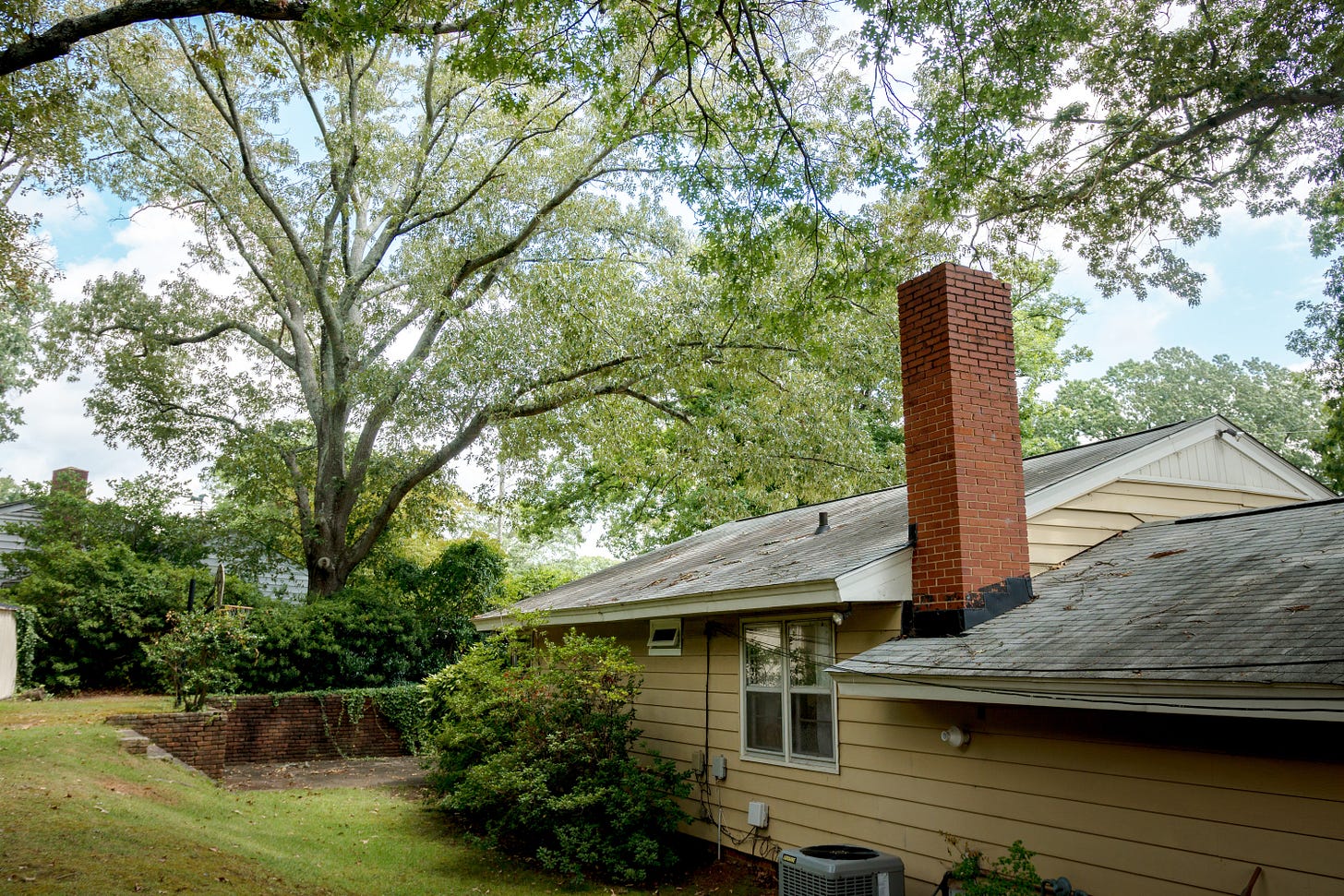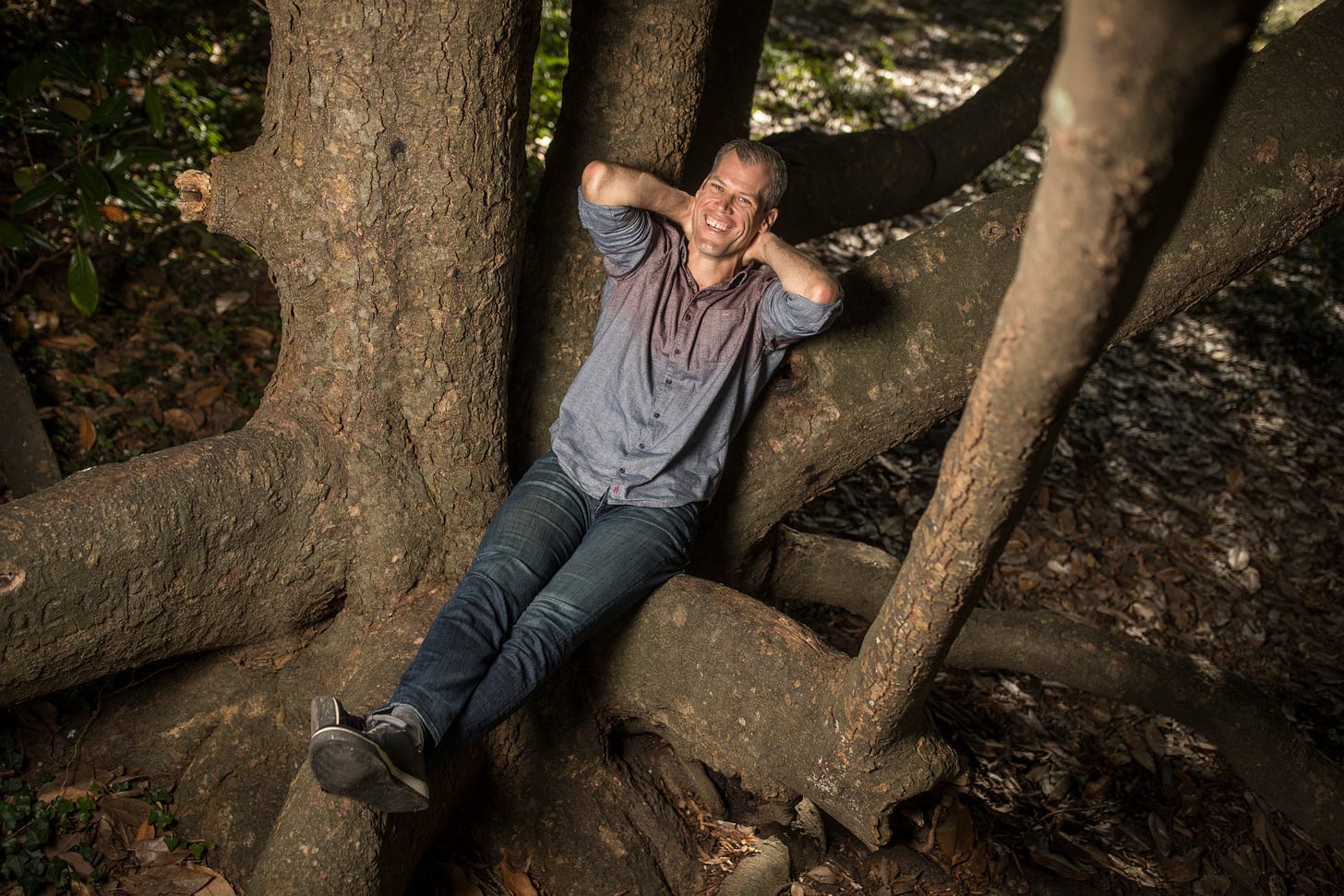🌳 Trees: Advice from a Treecologist
What to know before removing a tree, from arborist Basil Camu
As budding land stewards we want to trust our instincts, but what if our instincts about some things—like big, swaying, sidewalk-cracking trees—have been shaped more by fear than fact?
Below is an excerpt from Chapter 11 of Basil Camu’s book, From Wasteland to Wonder, where he walks us through some of the most common tree concerns he hears and how most of them don’t need to result in the death of the tree. If you’ve ever looked at towering branches near your home and felt torn between awe and anxiety, this one’s for you.
Trees We Generally Shouldn’t Worry About
After many years of working in the tree service industry, I have heard many unfounded fears and misinformation when it comes to trees and the supposed need to cut them down. Here are the concerns I hear most often and why they are not generally concerning.
“I saw my tree swaying in the wind (or a storm) and I’m worried it’s going to fall on my house!”
Tree movement is a good thing! They are supposed to move. As they move, trees grow stronger by developing something called response growth. Think about how we humans work our bodies to build muscle: we lift things, push things, and move around. Although the physiology is very different, the concept is the same: when trees move in the wind they grow stronger. In addition, trees have all sorts of amazing structural features that allow them to withstand high winds, such as leaves that reconfigure into cones to minimize drag, a high twistiness-to-bendiness ratio in the trunk, and tensile buttressing, to name a few.
In the face of a hurricane, tornado, or major wind event all bets are off, even for the strongest and most healthy trees. But even if we have no trees on our property, that storm system can still drop trees and branches from other sites onto our house or building. I have personally witnessed this on multiple occasions during various storms here in North Carolina. All this to say, there is no reason to remove a tree because of the possibility of extreme weather and most certainly no reason to remove a tree because it sways in the wind.
“The tree is too close to my house. I’m afraid it will fall and cause damage—and maybe kill someone!”
Live trees have springy branches full of leaves that act as sails when they fall. They tend to fall more slowly and land with less impact, creating less damage. Buildings rarely collapse; roofs are strong and are designed to protect those living and working below. In my experience, the most serious damage occurs when live trees puncture the roof and rain enters that hole, creating internal water damage. Dead trees are different—they fall with force. If these are located near a building or house and could cause harm, they should be removed.
For those worried that a tree will fall and kill someone we love, the chances of this happening are extremely low. To put the risk into perspective, a review of mortality data in the United States found that nationwide there were 407 deaths from wind-related tree failure during the 13-year period from 1995 to 2007. At the individual level, that comes out to about a one in 690,000 chance each year. Compare this to your chances of dying in a motor vehicle accident (one in 9,000) and by drowning (one in 76,000). These risks are far greater, yet many of us think little of driving multiple times every day (or relaxing in and around water).
“That tree is HUGE! It scares me so much—it needs to be cut down.”
The huge trees are generally the oldest trees. They have survived many years and weathered many storms. They have developed great strength and resilience in the face of many challenges. These are usually the safest trees we should fear the least. This assumes they have not been damaged or disturbed recently. An example of this would be a construction project nearby that caused damage to the tree’s root system. This warrants closer inspection—more on this soon.
“I need to remove the tree because its roots are cracking my pipes, damaging my foundation, raising my sidewalk, or ruining my parking lot.”
Roots in pipes, foundations, or lifting hardscapes often lead people to remove the offending tree. But this is usually unnecessary, resulting in wasted money and the loss of a healthy tree. Let’s start with pipes and foundations.
Tree roots seek food and water. They have no interest in foundations and pipes. Tree roots are like melted cheese; they ooze through and around objects, looking for the path of least resistance. They have no punching power. When roots encounter pipes and foundations that have no cracks, they turn and grow around or alongside these structures.
But if they encounter pipes and foundations with cracks, they often enter in search of water and other basic needs. These cracks usually occur due to improper installation, age, or settling. When plumbers, inspectors, and other technicians find roots in the pipe or foundation, they usually blame the root because they mistake correlation with causation. This basic mistake in logic has happened so often that trees now have a bad reputation for damaging pipes and other infrastructure, though they often play no part whatsoever in the damage. The solution is to prune the root and replace the pipe or fix the foundation, not to remove the tree. This will save us a lot of money on unnecessary tree removal costs.
With sidewalks and hardscapes in general, roots do tend to cause more issues. But there are many solutions that allow us to address the issue and preserve the tree. Here are some ideas:
o We can install root barriers on the outer edge of the hardscape to prevent roots from growing underneath. This is typically a proactive solution we must implement before the roots reach the hardscape.
o If a root is already causing an issue, we can prune the root and use a pavement grinder to sand down the portion of the hardscape that has been lifted. We may also be able to slide a root barrier in place to prevent future intrusions.
o There are companies that use subsurface injections of foam and epoxy to lift and level the hardscape. This can be a cheap, easy way to level a hardscape while leaving the tree and its roots intact.
o For sidewalks specifically, consider pouring an ADA-compliant rubber overlay or equivalent (there are many options) on top of the lifted portion.
o Maybe the hardscape is old and needs to be replaced? Resurface the area taking care not to damage the roots. We can do this by instructing our contractor to use a jackhammer and hand tools only and to avoid using heavy equipment near the roots. This will limit damage to the root system. Resurfacing allows us the opportunity to add more gravel and level the surface while leaving the roots intact.
The list goes on. I recommend exploring these and other options before making the decision to remove the tree. Here is a great resources for those interested in more:
And let’s not forget one last option: do nothing. I realize that at times there may be city or HOA requirements to address the issues. We should also consider the needs of the elderly, pregnant, folks who rely on wheelchairs, and so forth. But if these are not a concern, consider leaving things as-is.
“I want to thin out some trees to increase the health of the largest trees.”
It is normal for trees to grow in dense stands. This is typical in forests. Trees are stronger and healthier in groups than they are as individuals. In groups, their roots interlock and increase their holding power within the soil. They are less likely to blow over. From a safety and health aspect, thinning trees creates issues. It does not solve them. Better to ignore the situation and let the trees sort things out among themselves.
“I need to remove the tree because it is at the end of its lifespan.”
A tree does not reach the end of its lifespan unless it has a fatal health issue or a structural defect that could cause it to fall and create harm to those nearby. Does this tree have such an issue? Could the issue be addressed by improving its structure or health? We will learn how to do these things in Chapters 12 and 14. In the absence of an issue, trees live a very long time. Maples can grow to be 400 years old in the wild. Some pine species here in North Carolina can reach ages of 200 to 500 years. There are oaks in the UK that are over 1,000 years old.
The point of all of these examples is that there is either nothing to worry about or there are better, cheaper solutions available than removing the tree. Now let’s talk about trees we should potentially worry about… (continued in Chapter 11 of From Wasteland to Wonder)
I hope this excerpt is actionable advice to you or someone you know who’s side-eyeing a tree! Basil’s approach invites us to see trees not as ticking time bombs, but as dynamic, resilient beings that are not out to get us. Rather, they provide myriad overlooked benefits to us year after year.
Next, we’ll shift focus from what not to cut down, to a strategy for planting—specifically, Basil’s “pocket forest” approach and how small, intentionally dense plantings of saplings can help restore ecosystem function and make for surprisingly easier tree care.
As always, thank you for reading!
Andie
About our Guest
Basil Camu
Co-Founder, Leaf & Limb
Founder, Project Pando
Author, From Wasteland to Wonder: Easy Ways We Can Help Heal Earth in the Sub/Urban Landscape
From Wasteland to Wonder is a gift from Basil! It is available for free as an e-book and a hard copy can be purchased for just the cost of printing and shipping. Get your copy here and consider making a donation to Project Pando!






I love this! Especially the do nothing advice; everything made so much sense.
(Except for injecting foam and epoxy into the ground.) I' m glad I saw no mention of landscape fabric but what is the unspecified root barrier?